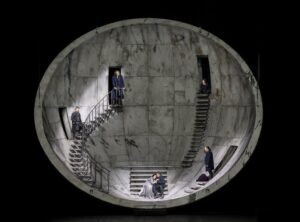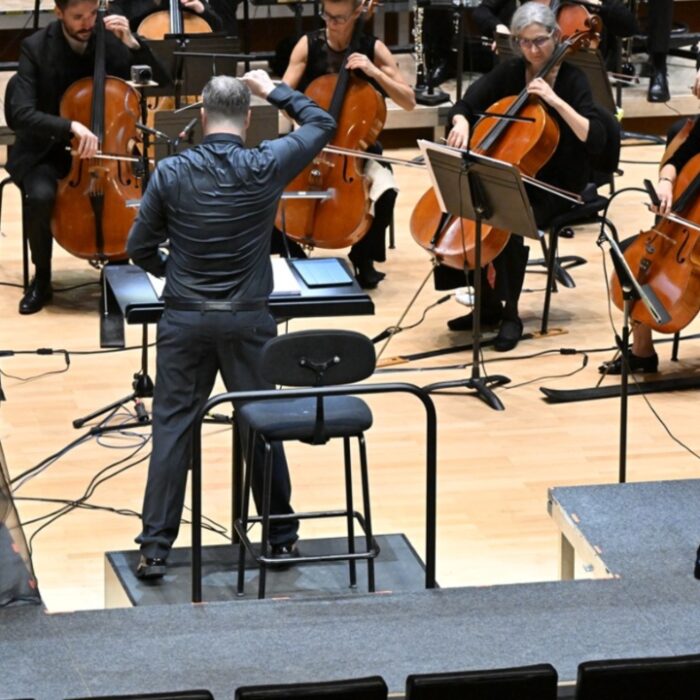
Palau de Les Arts 2022-23 review: Tristan und Isolde
Despite Questionable Leads, Àlex Ollé’s Inventive Production Elevated By a Brilliant Conductor & Solid Supporting Cast
By Mauricio VillaWagner had been absent from Valencia’s Palau de les Arts for 10 years. So it is understandable that its return, especially with “Tristan und Isolde,” was a reason for great anticipation and expectation. What’s more, tickets were almost sold out for every performance, and the reception at the curtain call was loud and enthusiastic.
Evocative & Original
Àlex Ollé, a member of La Fura dels Baus, directed the production, which previously bowed at the Opéra de Lyon.”
The set is impressive, made of plastic with a huge grey ball that hung in the air throughout the First act, and which when placed on the stage, turned around to create an immense dome on which the characters climbed or move up and down via several staircases. There was a rectangular platform which turned and formed different spaces, changing from metallic grilles of first act to the mud formations of the third act. The use of projections was very clever and measured, showcasing the moon in the hanging ball during first act, with trees, fire, and abstract elements taking over during the second and third act.
More importantly, Ollé accomplished this approach without the modern directorial crutch of creating a parallel dramaturgy. He simply staged the story while being truthful to the libretto and the music. No gimmicks. He knew how to adapt a realistic approach in the first act, which is all narrative, before transitioning the poetic and abstract long scenes of Acts two and three. Maybe the final scene was a bit simplistic, but in general the production was evocative, meaningful, and original.
Experienced Tenor With High Problems
The American tenor Stephen Gould sang the tittle role of Tristan. He has become a recognize “heldentenor” and has sung the role of Tristan all over the world, participating in 2015 Bayreuth production by Catharina Wagner. He has a baritonal timbre, dark and potent, with a solid low and middle register. Unfortunately, his high register has become weak. The vibrato of the voice becomes slower as he rises to the higher notes (Tristan does not go higher than A natural) and he has lost volume and projection. As a result, when singing his high notes, his voice often stood no chance next to his colleagues or even the orchestra. In his long interventions of Act three, some Gs and As natural sounded as if they were about to crack.
Things didn’t get off to such a rough start. His top register sounded fresh and secure at the end of Act one. Even at the start of Act two, with higher writing for the tenor that demands explosive and heroic timbre, he managed to sing comfortably.
But it was in the third act where Gould’s voice started to show signs of tiredness and the high notes sounded strained and pushed. It is true that most of the role lies in the middle register, but there are constant ascensions to high As in second and third act. Isolde is mostly singing along with him in second act, so the deficiencies of the high notes could be hidden or dissimulated, but the tenor is completely exposed during the multiple high As of third act. Nevertheless, there is a tremendous merit in singing such a long difficult role and finishing it with the voice intact. And despite that grievance about his high notes, Gould displayed his experience as a formidable Tristan, singing in perfect style, with immaculate German diction and a tremendous ability to color his voice. His last “Isolde” was hair-raising and the middle part of “O sink hernieder, nacht der liebe” was emotional and beautiful.
Ricarda Merbeth portrayed the title role of Isolde. She has a lyric dark timbre with a marked vibrato, secure high notes, and modest volume. She has solid control of her instrument and is secure throughout all her register. However, the role of Isolde is usually cast with heavier voices, and somehow she often sounded lacking in power.
The high B naturals of her narrative scene, during “gaberes preis,” were present because at that moment the orchestration is light and her voice is exposed. However, in that moment they sounded small and distant. It was a harbringer of what was to come. The two high Cs at the beginning of the love duet in the second act, during “wonneder seele” and “Himmel höchstes,” were completely overwhelmed by the dense and forte sound coming from the pit. Isolde’s most violent outbursts often fell short. Her first act lacked dramatism and she never quite managed to portrayed the anger and jealous that Isolde shows during this initial segment.
She sounded similarly overwhelmed during her “Liebestod,” and never quite managed to rise to the earth-shattering climax. After a long night of singing high and low, this final piece is quite central and does not go higher than A flat. Therefore the challenge lies on the interpretation and unfortunately, Merbeth sounded small and distant as her voice couldn’t match the several outburst and high climax of the orchestra; rather than the orchestra overpowering her, it sounded more like she couldn’t rise with the ensemble to this peak of musical expression.
That said, her final pianissimo F sharp on”lust!” was beautiful and her softer phrasing throughout the love duet were also among her finest moments on the night.
Extraordinary Support
Claudia Mahnke was an extraordinary Bragäne. With a dark powerful sound, she sounded much stronger than Merbeth during her spare interventions in Act one. Bragäne has one of the most beautiful moments of this opera in the second act, as she warns the lovers during “Einsam wachend.” This moment is usually sung offstage, but in this production Mahnke was at the top of the staircase inside the big doom. She produced a sweet, lyrical, and crystalline sound for this sublime moment.
Kostas Smoriginas was a strong Kurwenal whose voice melted perfectly with Gould. His biggest solo interventions are in the third act, where he sings full sections between Tristan’s delirium (Wagner was probably aware about the difficulties for the tenor to sing the third act and therefore included Kurwenal’s verses so that the tenor could rest his voice). Smoriginas sang fluently and effortlessly in an uncomfortable tessitura, navigating constantly between high E and F. His projection gave him vocal weight in the explosive moments, like when he sees Isolde’s ship arriving. He delivered a perfect ringing top high G in ”Heiha!heiha ha ha.”
Bass Ain Anger sang the role of König Marke. This role is marked by a long monologue in Act two and a few spare lines in the third act. Anger delivered an emotional and sorrowful interpretation of his long monologue with his velvety dark voice, long legato singing, and even timbre from low to high.
The work of James Gaffigan, in charge of the Orquesta de la Comunitat Valenciana, was remarkable. To begin with, he managed to find a perfect balance between the orchestra sound and the voices. Les Arts has a big orchestra pit that is completely open (some theaters have part of the orchestra under the stage) which makes it really hard for the voices in general to carry over dense and heavy sound.
Gaffigan was conscious of that, and instead of just focusing on the complex orchestration, he managed to create intense climaxes without overpowering the voices. Moreover, the conductor drove the orchestra to those big moments without losing the chromaticism that Wagner used throughout this opera (it is very easy, and very common, to find conductors that just play as loud as possible, blurring the richness of Wagner’s score). Additionally, Gaffigan showed his deep knowledge of the score in the meticulous presentation of every leitmotiv, which were all clearly audible and timbrically detailed, while managing moments of deep tension; examples include the overture, Marke’s monologue, and Tristan’s long agony.
Ultimately, this was a strong meaningful and respectful production, with a cast of Wagner’s specialists and an outstanding conductor in James Gaffigan.


